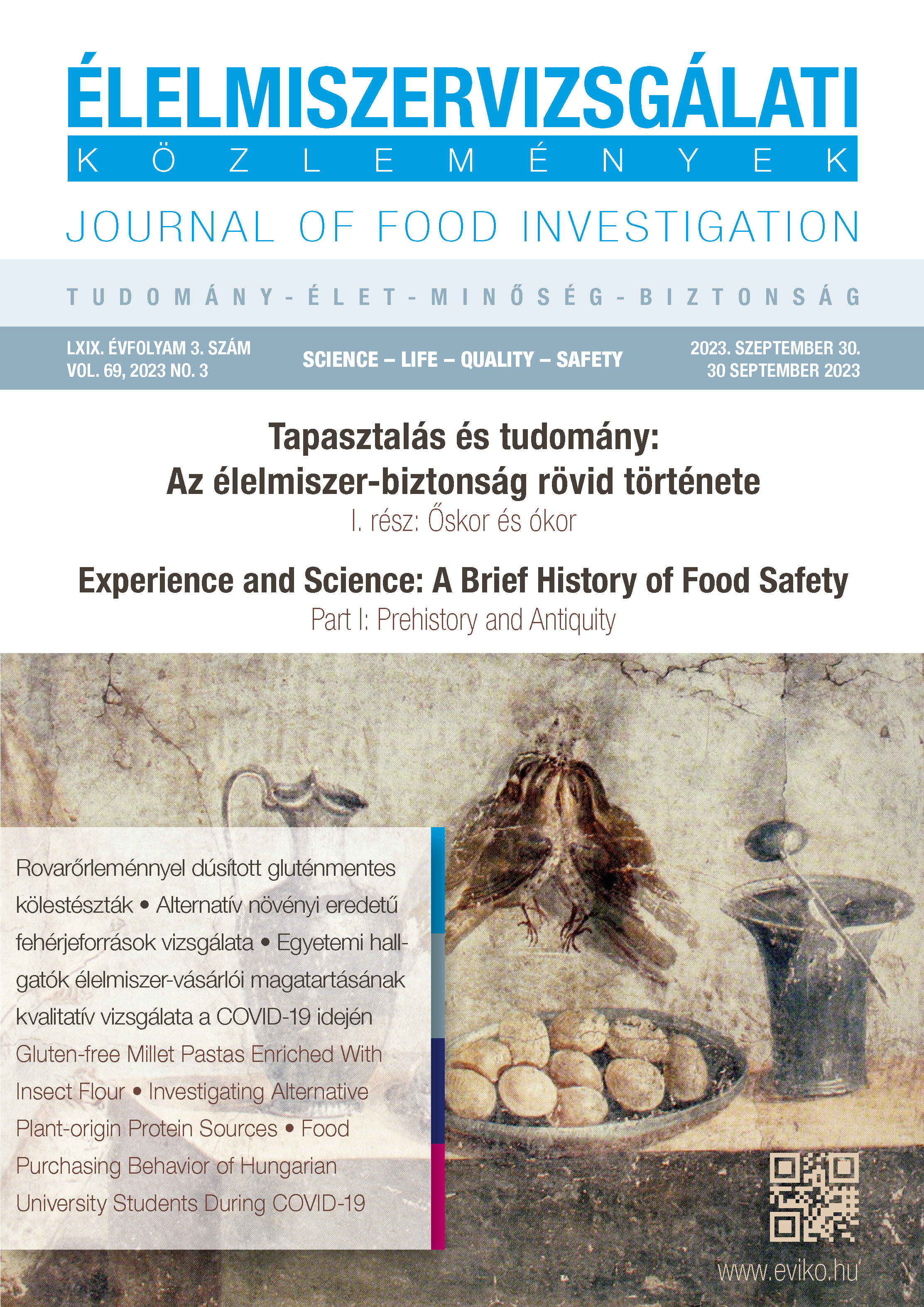Investigating Plant-origin Protein Sources – Abstract
Main Article Content
Abstract
In our research, we investigate whether plant proteins can replace animal proteins and crop production with a smaller ecological footprint can replace animal production to some extent. For this purpose, we selected plant raw materials (white quinoa, tricolour quinoa, sweet lupine, bitter lupine, and amaranth) that, based on their amino acid composition, could be suitable for replacing meat proteins or supplementing vegetable proteins. First, the total amino acid content of the samples was determined and compared to each other and to the FAO/WHO reference protein. Subsequently, the amino acid ratios (AAS) were calculated on the basis of the amount of essential amino acids. This ratio determines the relative deficiencies of the amino acids that constitute the protein in relation to the amino acid content of the reference protein. From this, the PDCAAS (protein digestibility corrected amino acid value) of the samples was calculated using the digestibility quotient (D%) found in the literature. The Daily Reference Value (DRV%) was then used to assess the degree to which the protein content of the food to be consumed meets the daily protein requirement. Our results suggest that the tested plants can be used as alternative protein sources in human nutrition, both in terms of protein content and amino acid composition, and thus can reduce the ecological footprint of food production by replacing animal proteins.
Downloads
Article Details
References
Lászay Gy. (2003): Táplálkozás-Élettan Budapest: FVM Képzési és Szaktanácsadási Intézet
SZTE. (2012): „Az vagy, amit eszel” Táplálkozásbiokémia, patobiokémia. https://www.u-szeged.hu/download.php?docID=55784
Salgó, A. (2001): Élelmiszerkémia és Táplálkozástan I. Budapest: Műegyetemi Kiadó
Singla P., Sharma S., Singh S. (2017): Amino Acid Composition, Protein Fractions and Electrophoretic Analysis of Seed Storage Proteins in Lupins. Indian Journal of Agricultural Biochemistry 30 (1), 33-40., DOI: 10.5958/0974-4479.2017.00005.3
Escuredo O, Martin G., Moncada G., Fischer S., Hierro J. (2014): Amino acid profile of the quinoa (Chenopodium quinoa Willd.) using near infrared spectroscopy and chemometric techniques. Journal of Cereal Science, 60 (2014) 67-74., DOI: 10.1016/j.jcs.2014.01.016
Petras R. Venskutonis P.R., Kraujalis P. (2013): Nutritional Components of Amaranth Seeds and Vegetables: A Review on Composition, Properties, and Uses DOI: 10.1111/1541-4337.12021
FAO (2013): Dietary protein quality evaluation in human nutrition. Report of an FAO Expert Consultation, 31 March–2 April, 2011, Auckland, New Zealand
Comai, S., Bertazzo, A., Bailoni, L., et al. (2007) The Content of Proteic and Nonproteic (Free and Protein-Bound) Tryptophan in Quinoa and Cereal Flours. Food Chemistry, 100, 1350-1355. DOI: 10.1016/j.foodchem.2005.10.072
Escuredo O, Martin G., Moncada G., Fischer S., Hierro J. (2014): Amino acid profile of the quinoa (Chenopodium quinoa Willd.) using near infrared spectroscopy and chemometric techniques. Journal of Cereal Science, 60 (2014) 67-74., DOI: 10.1016/j.jcs.2014.01.016
Maradini-Fiho (2017): Quinoa: Nutritional Aspects iMedPub Journals, Vol. 2 No. 1: 3 http://nutraceuticals.imedpub.com/archive.php
Amare E., Claire -Rivier M., Servent A., Morel G., Adish A, Haki G. (2015): Protein Quality of Amaranth Grains Cultivated in Ethiopia as Affected by Popping and Fermentation. Food and Nutrition Sciences, 6, 38-48. DOI: 10.4236/fns.2015.61005
Písaříková B, Kráčmar S., Herzig I. (2005): Amino acid contents and biological value of protein in various amaranth species. Czech J. Anim. Sci., 50 (4), 169–174. DOI: 10.17221/4011-CJAS
Narwade S, Pinto S. (2018): Amaranth - A Functional Food. Concepts of Dairy & Veterinary Sciences 1(3). CDVS. MS. ID. 000112. DOI: 10.32474/CDVS.2018.01.000112
Schaafsma, G. (2000): The protein digestibility-corrected amino acid score. J Nutrition, 130 (7), 1865S-1867S. DOI: 10.1093/jn/130.7.1865S
Boye j, Zare F, Pletch A (2010): Pulse proteins: Processing, characterization, functional properties and applications in food and feed. Review. Food Research International 43 (2010) 414–431. DOI: 10.1016/j.foodres.2009.09.003
Code of Federal Regulations: 2000–2006. január 1. U.S. General Services Administration, National Archives and Records Service, Office of the Federal Register 21 CFR, Ch1(4-1-06) 101.54.

